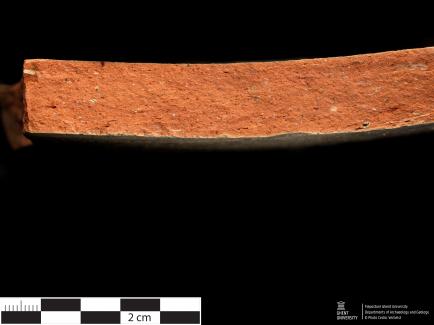Post Medieval - Tin glazed (majolica & faience) (7.TG.BE.0018)
Hand specimen pictures (macro & binocular)
Thin section pictures
Find location
- Category
- Tin glazed (majolica & faience) (Post Medieval)
- Fabric name
- biscuit
- Chronology
- Post Medieval > Modern > 1556-1561/1562
- Dating method(-s)
- historical sources, typology, iconography
- Potters' mark
- No
- Additional information
- biscuit waster (wall fragment); referred to as "rough fired ware"
Find location
- Site type
- Pottery production
- Location
- Belgium; Antwerpen; Antwerpen
- Site name
- Antwerpen, Steenhouwersvest
- Excavation or Survey Team
- Afdeling Opgravingen, Stad Antwerpen
- Additional contextual information
- site code: A117; context information: A117/o/x37; excavation 1993 (kiln + production waste); attributed to the workshop/pottery company of Lucas Andries (atelier De Goudbloem)
- Surface color
- beige
- Surface texture
- Smooth
- Fracture color
- orange
- Inclusions (non-plastics/tempering)
- quartz; iron oxides (?); amorphous and oval red and white to beige inclusions (clay pellets ? grog ?); rare black inclusions (?); white porous inclusions,
- Matrix and voids
- very thin vughs; fine white clay lenses ?
- Diagnostic features
- Additional information
- sample ANTW_SV_ST1b
- Flepostore inventory nr.
- ARCH1.L1.C8b
- Original inventory nr.
- A0049
- Collection
- Archaeological Department, Ghent University
- Type
- Covered thin section
- Comparable thin section(s)
- Matrix
-
Oxidised orange-red fabric; dark brown (PPL), dark brown (XP).
Homogenous matrix, non-calcerous with no optical activity: matrix partly near sintering/vitrification due to overfiring.
- ca. 55-70% - Inclusions
-
Quartz (++; mono+, poly-), sedimentary rock detritus (+-; quartz arenite), chert/flint (+-; ff), metamorphic rock detritus (+-, low grade), feldspars (-; plagioclase, microcline, orthoclase), muscovite mica (-; el), glauconite (-; uncertain, red body color, ff); O/Fe (+-), clay pellets (+-; iron-rich).
The coarse fraction consists of medium sand, the fine fraction consists of very fine to fine sand, possibly bimodal (natural). Grains are generally rounded to subrounded. Overall the fabric is poorly sorted and moderately to poorly orientated, single to open spaced.
- ca. 20-30% - Voids
-
Large vughs and channels, well aligned, some infill.
- ca. 10-15% - Diagnostic features
- The fabric is characterized by a homogenous oxidised matrix with no optical activity (overfired: partly vitrified) and moderate porosity. Dominant quartz inclusions with common sedimentary and metamorphic rock detritus, chert/flint, opaques/iron oxides and iron-rich clay pellets, few feldspars, muscovite mica and glauconite. Overall poorly sorted fabric.
- Additional information
- Mineralogical information lost from misfiring. Similar to A0049a, but overfired to a lesser degree.
- Sample type
- Pottery
- Inventory number
- 7.TG.BE.0018
- Collection
- Archaeological Department, Ghent University
- Donating institute/person
- Onroerenderfgoeddepot, Stad Antwerpen
- Host collection
- Onroerenderfgoeddepot, Stad Antwerpen
- Other samples available
- No
- Sample collection method
- Archaeological Excavation
Dumortier & Veeckman 1994
- Full reference
-
Dumortier C. & Veeckman J. 1994. Un four de majoliques en activité à Anvers vers 1560. Bulletin van de Koninkljke Musea voor Kunst en Geschiedenis. Jubelpark Brussel 65: 163-217.
Veeckman 1994
- Full reference
-
Veeckman J. 1994. Een majolica-oven aan de Steenhouwersstraat te Antwerpen (Antw.). Archaeologia Mediaevalis 17: 5-7.
Cite this page as: Flepostore - https://flepostore.ugent.be/ceramics/7-tg-be-0018
Last modified: 2024-04-23.





